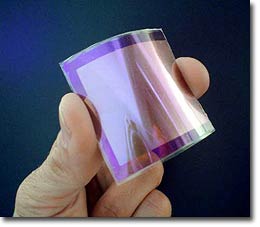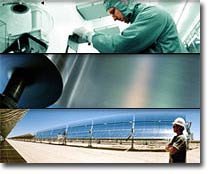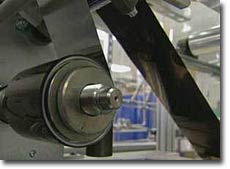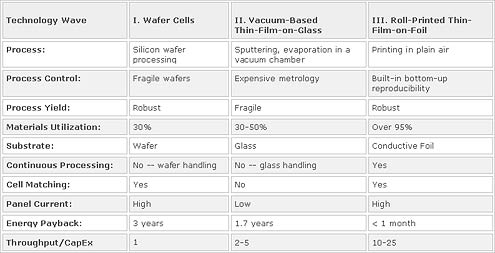
Nanosolar’s Breakthrough - Solar
Now Cheaper than Coal
Nov 23, 2007 - Jessica Hunt - Celsias
 Their
mission: to deliver cost-efficient solar electricity.
The Nanosolar company was founded in 2002 and is working
to build the world’s largest solar cell factory in
California and the world’s largest panel-assembly
factory in Germany. They have successfully created
a solar coating that is the most cost-efficient solar
energy source ever. Their PowerSheet cells contrast
the current solar technology systems by reducing the
cost of production from $3 a watt to a mere 30 cents
per watt. This makes, for the first time in history,
solar power cheaper than burning coal. Their
mission: to deliver cost-efficient solar electricity.
The Nanosolar company was founded in 2002 and is working
to build the world’s largest solar cell factory in
California and the world’s largest panel-assembly
factory in Germany. They have successfully created
a solar coating that is the most cost-efficient solar
energy source ever. Their PowerSheet cells contrast
the current solar technology systems by reducing the
cost of production from $3 a watt to a mere 30 cents
per watt. This makes, for the first time in history,
solar power cheaper than burning coal.
These coatings are as thin as a layer
of paint and can transfer sunlight to power at amazing
efficiency. Although the underlying technology has
been around for years, Nanosolar has created the actual
technology to manufacture and mass produce the solar
sheets. The Nanosolar plant in San Jose, once in full
production in 2008, will be capable of producing 430
megawatts per year. This is more than the combined
total of every other solar manufacturer in the U.S.
 |
|
Nano Particles
|
Nanosolar, Inc. prides themselves on
being the “Third Wave” of solar technology. The “First
Wave” began over three decades ago with the introduction
of silicon wafer based solar cells. This technology
bore high material and production costs with poor
capital efficiency. Silicon does not absorb light
very well and therefore, the silicon wafers must be
very thick. Also, the wafers are extremely fragile.
Their need for intricate handling complicates processing
all the way up to the final panel product.
 The
“Second Wave” came about a decade ago with the first
“thin-film” solar cells. This established that a cell
100 times thinner than the solar wafers can work just
as well. However, this process also has its setbacks.
First, the cells semiconductor was deposited using
slow and expensive high-vacuum based processes. Secondly,
the thin films were deposited directly on glass as
a substrate. This eliminated the possibilities of: The
“Second Wave” came about a decade ago with the first
“thin-film” solar cells. This established that a cell
100 times thinner than the solar wafers can work just
as well. However, this process also has its setbacks.
First, the cells semiconductor was deposited using
slow and expensive high-vacuum based processes. Secondly,
the thin films were deposited directly on glass as
a substrate. This eliminated the possibilities of:
* Using a conductive substrate directly
as electrode (The Nanosolar cells work on a metal
foil substrate, or semiconductor, instead of the stainless
steel or glass substrate. The metal foil semiconductor
creates an increase in yield of 20%);
 *
Achieving a low-cost top electrode of high performance
(An electrode is a conductor through which electricity
flows.); *
Achieving a low-cost top electrode of high performance
(An electrode is a conductor through which electricity
flows.);
* Employing the yield and performance
advantages of individual cell matching & sorting (The
effect of electrical mismatch per cell leads to greater
losses per panel as a result, and panel yield and
efficiency distribution suffer: A bad cell results
in a bad panel with thin-film-on-glass technology;
but with a cell-sorting technology, only that cell
will be a loss);
* Employing high-yield continuous roll-to-roll
processing (Roll-to-roll processing allows large quantities
of material to be processed with equipment that leaves
a small footprint);
* Developing high-power high-current
panels with lower balance-of-system cost {Nanosolar.com}.
To put it simply, the production cost was still too
high and the product did not yield a high enough output
of energy. Nanosolar, however, brings together the
entire conjunction of all seven areas of innovation
which delivers a dramatic improvement in cost efficiency,
yield and throughput of the production of much thinner
cells than ever before.

Nanosolar offers a 25 year warranty on its products.
They test their products in much harsher conditions
than the official certification standards. They expose
the cells to intense UV light as well as intense humidity.
This in depth testing allows for Nanosolar to produce
a quality product with efficient output in all environments.
YouTube link :http://www.youtube.com/watch?v=4riNlqZHCTQ&eurl=http://www.celsias.com/2007/11/23/nanosolars-breakthrough-technology-solar-now-cheaper-than-coal/

|